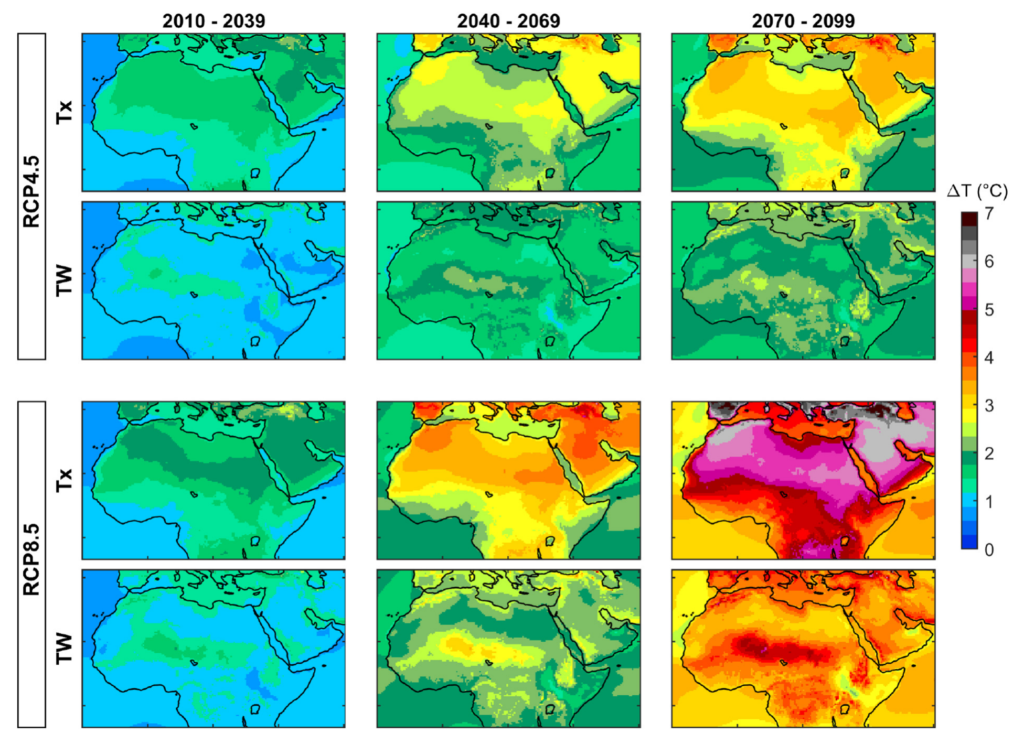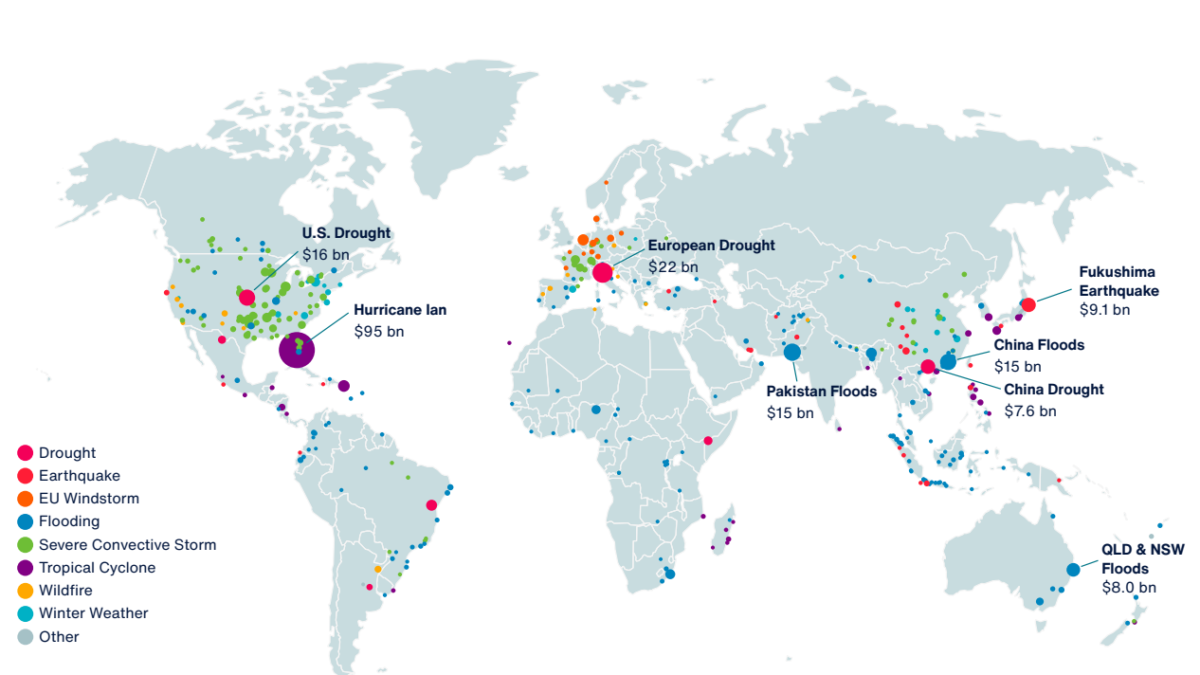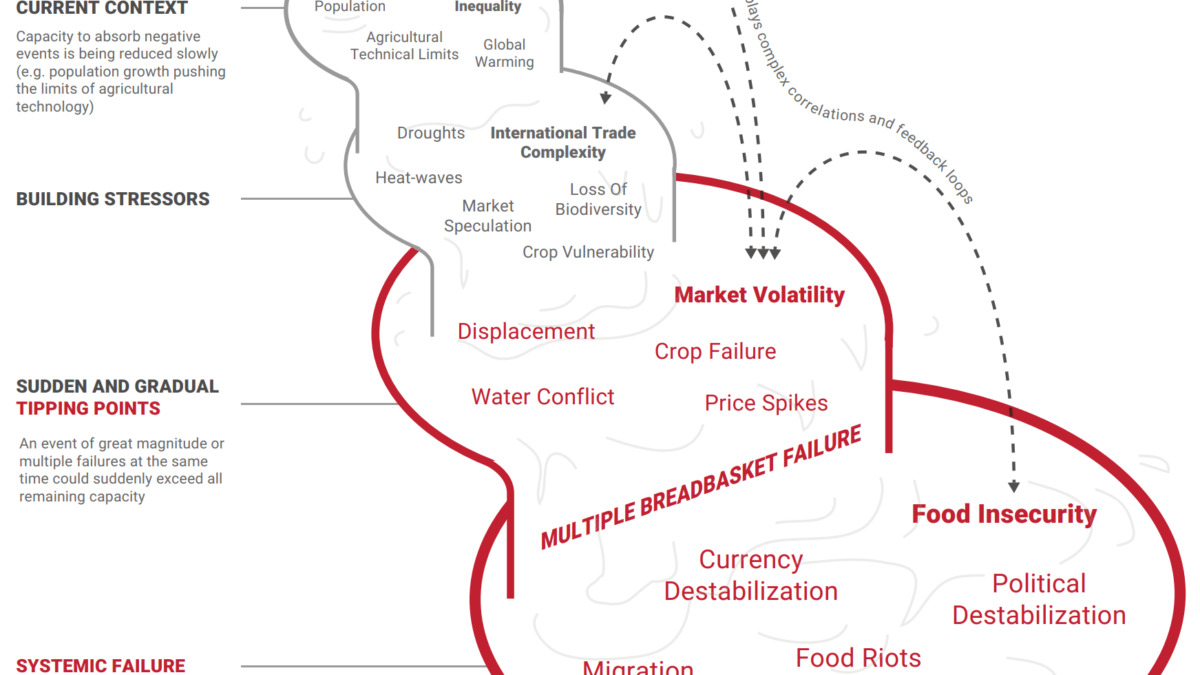Deadly heat waves in Middle East and North Africa to increase by 8–20 times if global warming isn’t slowed
By Ali Ahmadalipour and Hamid Moradkhani
12 May 2018
(Environment International) – Climate change will substantially exacerbate extreme temperature and heatwaves. The impacts will be more intense across the Middle East and North Africa (MENA), a region mostly characterized by hot and arid climate, already intolerable for human beings in many parts. In this study, daily climate data from 17 fine-resolution Regional Climate Models (RCMs) are acquired to calculate wet-bulb temperature and investigate the mortality risk for people aged over 65 years caused by excessive heat stress across the MENA region. Spatially adaptive temperature thresholds are implemented for quantifying the mortality risk, and the analysis is conducted for the historical period of 1951–2005 and two future scenarios of RCP4.5 and RCP8.5 during the 2006–2100 period. Results show that the mortality risk will increase in distant future to 8–20 times higher than that of the historical period if no climate change mitigation is implemented. The coastal regions of the Red sea, Persian Gulf, and Mediterranean Sea indicate substantial increase in mortality risk. Nonetheless, the risk ratio will be limited to 3–7 times if global warming is limited to 2 °C. Climate change planning and adaptation is imperative for mitigating heat-related mortality risk across the region.
Introduction
Global warming will increase the frequency and intensity of heat-waves and extreme high temperatures (Fischer and Knutti, 2015; Mora et al., 2017; Pal and Eltahir, 2016). Even if the global mean temperature increase is limited to 2 °C, the warming over land will be far beyond 2 °C in many regions (Coff el et al., 2017; Fischer et al., 2013; King et al., 2017). The social impacts of climate change and extreme temperatures garnered more attention after the 2003 European heatwave which caused high mortality (Christidis et al., 2015; Li et al., 2016). The ongoing anthropogenic temperature rise has raised serious concerns regarding human health (Kingsley et al., 2016; Mitchell et al., 2016; Williams et al., 2012) and economy (Dunne et al., 2013; Underwood et al., 2017; Zander et al., 2015; Zhao et al., 2016). Climate change has already prolonged the heatwaves and increased their frequency in various locations of the world (Sun et al., 2014). The severe heatwaves of Texas in 2011 (Luo and Zhang, 2012), Australia in 2012 (Lewis and Karoly, 2013), China in 2015 (Miao et al., 2016), and Egypt in 2015 (Mitchell, 2016) were all experienced at large spatial extent and prolonged duration.
The anthropogenic warming in MENA is strongest in summer; whereas elsewhere it is usually stronger in winter (Lelieveld et al., 2016; Waha et al., 2017). Considering the hot arid climate of the majority of MENA region, the morbidity and mortality risk of extreme high temperatures is one of the grand challenges facing human health and society (Russo et al., 2016). Studies have demonstrated that climate change will increase air temperature across the Middle East to thresholds not tolerable for human body, especially around the Persian Gulf (Im et al., 2017; Pal and Eltahir, 2016). Schär (2016) discussed that the air temperature has already exceeded the postulated tolerance threshold in some humid areas around the Persian Gulf (e.g. Bandar Mahshahr, Iran). When exposed to hot temperatures, human body dissipates heat by sweating and increasing heart rate in order to increase blood flow to the body surface, which in turn reduces the oxygen supply to muscles and brain. In addition, dehydration increases the blood viscosity and makes it harder for the heart to circulate it. The physiological processes caused by increased core body temperature result in mental and physical fatigue, and augment the likelihood of exhaustion, heart attack, and mortality (Kjellstrom et al., 2016; Loughnan et al., 2010; Ross et al., 2018). Accordingly, multitude of studies have projected significant increase in heat-related morbidity and mortality by the end of 21st century due to exposure to higher ambient temperatures (Chen et al., 2017; Ostro et al., 2012; Peng et al., 2011; Weinberger et al., 2017).

Several studies have investigated the mortality risk caused by extreme temperatures, some of which merely focused on the relationship (mostly linear correlation) between the global warming rate and the changes in mortality (Huber et al., 2017; Mazdiyasni et al., 2017). It has been discussed that climate change is not the only cause for mortality, and that heat-related mortality may occur at any time and any location (Loughnan et al., 2010; WHO, 2014). Therefore, health risk models have been developed in recent years to quantify the heat-related mortality risk and the impacts of climate change on it (Honda et al., 2014; Loughnan et al., 2012; Merte, 2017). The current study investigates the impacts of climate change on mortality risk of people aged over 65 years using a recently developed health risk model.Dry-bulb temperature (simply referred to as temperature) is different from the temperature that the body feels. Humidity, radiation, and wind speed are among the factors influencing the real-feel temperature that human body experiences (Knutson and Ploshay, 2016; Willett and Sherwood, 2012). Therefore, wet-bulb temperature (TW) has been proposed as a proxy of the real-feel temperature, and it has been utilized as a measure for human discomfort (Dunne et al., 2013). The primary benefit of utilizing TW rather than dry-bulb temperature is that TW better represents the real-feel temperature that human body experiences (Mitchell et al., 2016; Pal and Eltahir, 2016; Willett and Sherwood, 2012). Moreover, TW is more confined compared to the dry-bulb temperature and it is more reliable for assessing human health-related issues (Raymond et al., 2017; Zhao et al., 2016).
Despite the multitude of heat-related mortality assessments, a comprehensive and rigorous analysis of climate change impacts on mortality risk of the MENA region is missing. Many of the previous analyses either employed a simplified methodology, utilized coarse resolution (temporal and spatial) data, or focused on a limited study period. The application of raw air temperature data, rather than the more reliable wet bulb temperature, is another deficit in many previous analyses. Moreover, uncertainty is an intrinsic feature of climate change assessments, and accurate characterization of the uncertainty helps providing more reliable projections, which will be beneficial for mitigation planning purposes (Ahmadalipour et al., 2018). Inaccurate representation of the climate change uncertainties is a common shortcoming of many previous assessments, and that is generally caused by limited number of climate models and scenarios employed as well insufficient parameterization of the impact model used (Ahmadalipour et al., 2017a; Rana et al., 2017).
The current study investigates the impacts of global warming on the mortality risk of people over 65 years of age caused by extreme high temperatures. A large ensemble of regional climate models (RCMs) is employed to calculate daily TW across the MENA. The mortality risk is then quantified using a recently developed health risk model, and the impacts of climate change on the mortality risk are investigated. The data, models, and methodology are explained in the next sections, followed by results and discussion. […]
Summary and conclusion
In this study, daily maximum near-surface air temperature and humidity from 17 RCMs are utilized to quantify the impacts of climate change on mortality risk caused by excessive heat stress. A recently developed health risk model is employed to quantify mortality risk using a spatially dynamic optimum temperature threshold. The analysis is applied to the historical period of 1951–2005 and two future scenarios of RCP4.5 and RCP8.5 for the period of 2006–2100. The main findings of this study are summarized as follows:
- The fine-resolution CORDEX RCMs accurately capture regional land cover and elevation effects on mortality risk.
- ΔTx and ΔTW (changes of dry- and wet-bulb temperature) show linear relationship over water. Whereas over land, ΔTx is always higher than ΔTW.
- The highest (least probable) mortality risk ratio from RCP4.5 is lower than the median (most probable) mortality risk projected by RCP8.5 in distant future, which emphasizes the necessity of climate change mitigation.
- The coastal regions of the Red sea, Persian Gulf, and the Mediterranean Sea indicate substantial increase of mortality risk.
- The mortality risk ratio shows a similar latitudinal pattern over time, and the 12°N latitude indicates the highest increase of mortality among others, with the highest uncertainty. [more]


